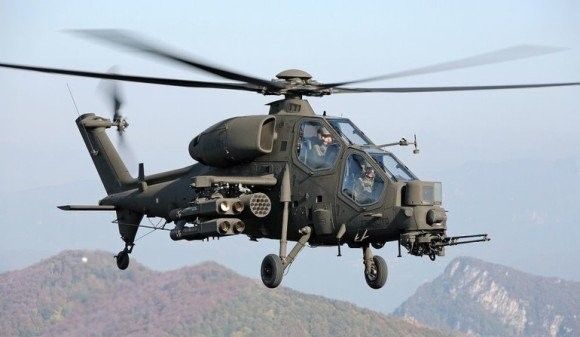Industry
Polish Armament for the Helicopters
Helicopters have been one of the most vividly discussed topics, with a reference to modernization of the Polish Armed Forces. Regardless of the final schedule concerning the introduction of aircraft in the specific classes into service (i.e. attack or multi-role platforms), it is also required to define the armament kit that would be used by them. The Polish industry, including the PGZ Group companies, is in possession of proper competency in the said domain, which may be further expanded through a relevant transfer of technology.
Light missiles carried in missile pods remain the primary ordnance for the attack and multi-role helicopters. The technological evolution has led to a situation in which such rockets may also feature a guidance system, even though, previously, solely unguided projectiles could have been placed in a package of so small size.
Mesko company has also concluded a cooperation agreement concerning this class of systems with the Kongsberg, Raytheon and Thales companies. In case of the latter company, Thales, the proposal concerns the cooperation in the area of manufacturing of the latest guided and unguided 68 mm induction missiles.
When it comes to Raytheon and Kongsberg companies, the letters of intent signed concerned introduction of 70 mm laser guided rockets into production. The said rockets can be easily integrated across a variety of platforms. Their design is based on the NATO standard Hydra unguided 70 mm rockets (2.75 inch).

The 70 mm rockets manufactured by Mesko could also be based on the NLPR 70 mm projectiles which are already included in the offer of the company and are compliant with the NATO standards. With a range of 2 kilometres the said rockets may be used to attack targets, carrying a variety of 6 kg warheads. They constitute armament dedicated for a number of platforms, along with the WW-15 launcher manufactured by Mesko, holding 15 rockets, or the WW-4/N launcher developed by ZM Tarnów, holding 4 rockets. The whole system has been developed within the framework of a programme, the goal of which would be to tailor the Polish armament to the NATO standards, in order to replace the post-Soviet 57 and 80 mm rockets.
Both guided, as well as unguided rockets manufactured by Mesko, could become a part of the armament inventory for the helicopters operated by Poland. This concerns both the armed CSAR multi-role helicopters, as well as the modernized helicopters operated now. Same applies to the prospective rotary-wing aircraft that are to be procured via the Kruk attack helicopter tender. With the smaller launchers, this type of armament may be used onboard the Zefir- and Gryf-class UAV systems.
The rocket offer of the Polish industry may be complemented with Grom/Piorun missiles in an air-to-air variety. So far such missiles have not been certified to be carried by the helicopters, however, relevant works are already going on.
Gad-system had also been introduced into use in the Polish Army, utilizing the Striela-2M missiles. The said solution has been operated with W-3 and Mi-2 helicopters and PZL-130 Orlik aircraft. A variant using the Grom and Piorun launchers may be a replacement of the aforesaid solution. Attempts of adapting the Grom missiles for use on the W-3 Sokół/Głuszec helicopters were made as early as back in 2000, within the framework of the Gad-G programme.
Anti-Tank Missiles
At the moment the helicopters of the Polish Armed Forces have no ability to utilize ATGMs. The said capability has been lost once the operational lifetime of the Mi-24D/W helicopters has ended. The abilities possessed by the attack helicopters are a priority, as it has been confirmed by the provisions contained within the Strategic Defence Review. The emerging situation requires immediate steps to be taken to reverse it.
During the last year’s MSPO Defence Salon W-3PL Głuszec helicopter has been presented, carrying Spike-ER missiles with a range of 8 kilometers and Spike NLOS missiles that remain capable of striking targets beyond the line of sight, at distances of up to 25 kilometers. Black Hawk helicopters, for instance, also have an ability of using the Spike missiles in a variety of variants.
A few years ago Israel has finalized tests of a modified “Battlehawk” helicopter, integrated with the Spike-ER ATGM system. On the other hand, the Columbian authorities have decided to arm their UH-60L Black Hawk helicopters with the Spike NLOS (25 km of range), Spike-ER and Spike-LR (range of up to 4 kilometers) missiles.
Spike-ER missile is also integrated with the Airbus Helicopters Tiger gunship, Israel has been working on integrating the said weapon with the Apache helicopter.
At the same time, another variant of the Spike-LR missiles is being license manufactured by the Mesko company. The representatives of the Rafael company had also been declaring their readiness to “polonize” other varieties of the Spike missile, should a decision be made to introduce the said weaponry into the inventory of the Polish Armed Forces.
At the moment, analysis is carried out concerning the acquisition of a new type of ATGM for the Polish Army, also with a prospect of that missile being used by the attack helicopters. The process is in its infancy, hence a variety of proposals is being taken into consideration. When the aforesaid proposals are assessed, potential chances of industrial collaboration shall also be taken into account. Regardless of the ultimately selected solution, it would be justified to start production domestically, as well as to establish potential for maintenance, operational support and prospective modernization.

Guns
Alongside the rocket armament, PGZ Group may also offer guns of a variety of types for the Polish helicopter platforms. Here we are referring to .308 UKM-2000 machine guns, and .50-cal. WKM-B machine guns, with both weapons being manufactured by Tarnów in variants that may be carried by aircraft. This concerns both electric-trigger unit variant, as well as versions that may be operated manually, by a gunner. Both weapons utilize NATO-standard ammunition and, for years, have been used by the Polish Armed Forces.
ZM Tarnów also offers LZS-12.7 gun pods in two variants, fitted with a WKM-Bm .50-cal. machine gun or multi-barrel WLKM-Bm .50-cal. machine gun. The aforesaid gun-pod is slung under an external hardpoint, and is tailored to be used both with the NATO as well as with Warsaw-Pact platforms. Alongside the gun, the pod also houses from 250 to 320 rounds of ammunition.
Multi-barrel WLKM 12.7x99 mm machine gun is an original design developed by ZM Tarnów. The 50 kg six-barrel .50-cal. machine gun may be used to attack targets at the distance of up to 2000 meters, with theoretical rate of fire of 3600 rpm.
This type of weapon may be used at a gunner-station, in a form of a gun pod, or as a remote-control turret. ZSW-12.7 remote control turret manufactured by ZM Tarnów carries 320 .50-cal. rounds for the WKM-Bm gun. This variant is being used as an armament of the W-3PL Głuszec helicopter.
Nonetheless, there is also an option of equipping the said helicopter with a six-barrel WLKM machine gun, of the same calibre. Once the ZSW-12.7 turret is integrated with the optronic sensor and weapons computer of the helicopter, the system may be installed and become the armament of any helicopter introduced into the inventory of the Polish Armed Forces. It is also possible to integrate the weapon on the Black Hawk, H225M Caracal or CSAR AW101 rotary-wing aircraft.

All of the aforesaid options concerning the armament for the Polish helicopters are based upon the abilities that currently remain in possession of the companies belonging to the PGZ Group. Introducing some of the above armament into production, such as the guided air-to-ground missiles, requires further work to be undertaken. The implementation may only be driven by the decisions taken by the Polish Ministry of Defence, with a proper advance given to the industry, within the scope of requirements defined for the Polish industry, as a part of the Technical Modernization Plan and other long-term action plans.
The armament for the new attack and close support helicopters, or even the UAVs, shall be unified to a large extent. Thanks to the above, creating manufacturing capabilities domestically may become more beneficial, as costs of operation may be limited.
This could happen on condition that decision on procurement of proper armament is taken early enough, especially with regards to the guided weapons. In this way integration of the given weapons system may be planned in advance with a reference to the given platform (helicopter, UAV). At the same time, domestic industrial potential may be created with regards to production, operational and maintenance support dedicated for the given weapons system.
Thus it would be justified to make decisions regarding the selection of armament such as guided and unguided rockets as soon as possible, preferably now. Not only should the said decision precede the selection of the Kruk programme helicopter, or in the multi-role helicopter tender, as it should also be taken before a selection of the Zefir UAV is made which is expected to be capable of carrying guided munitions used by other air platforms operated by the Polish Armed Forces.




